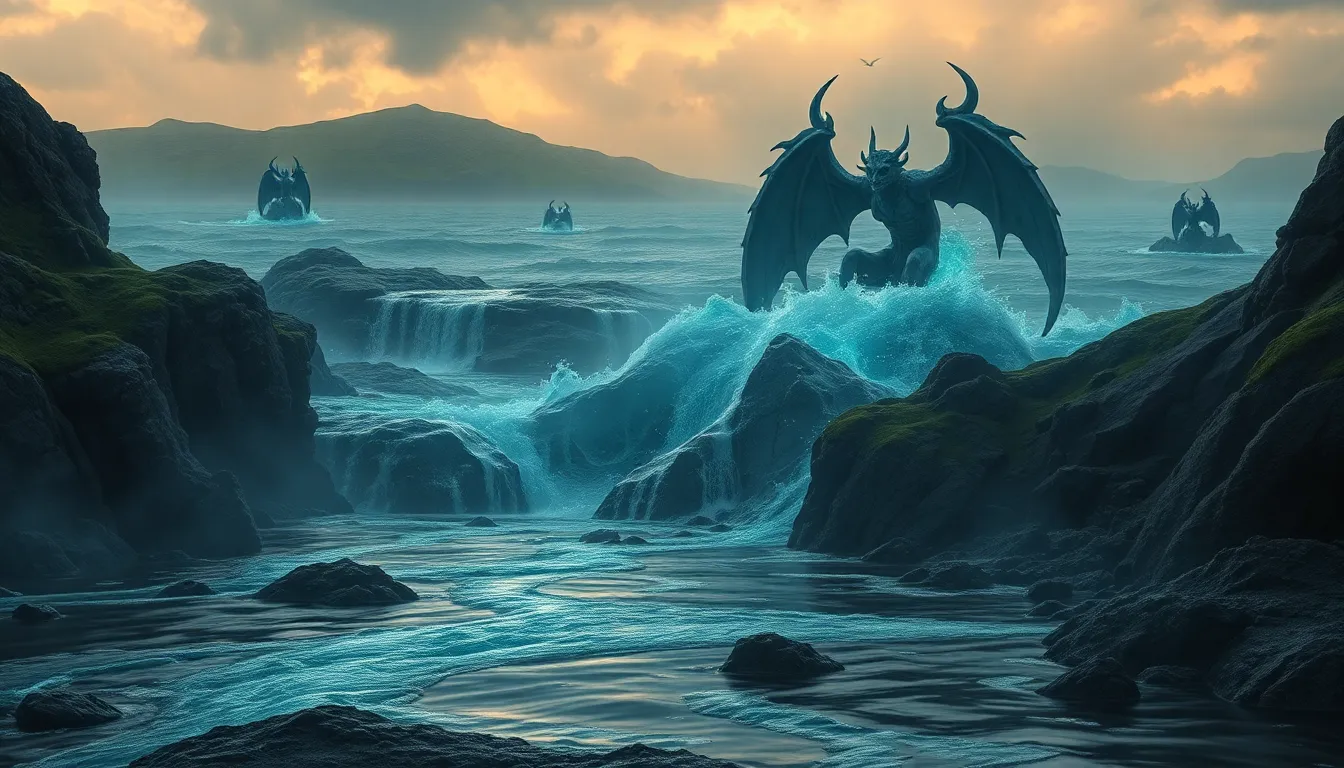The Flood Myths of the Celts: Water Spirits and Legends
I. Introduction
Flood myths are a recurring theme found in various cultures around the world, often reflecting humanity’s relationship with nature and the elemental forces of water. In Celtic mythology, water holds a significant place, embodying both life and destruction. This article aims to explore the rich tapestry of Celtic flood myths and their connection to water spirits, shedding light on how these stories reflect the Celts’ understanding of their environment and the supernatural.
II. Historical Context of Celtic Mythology
A. The Celts: An overview of their culture and beliefs
The Celts were a diverse group of tribal societies in Iron Age and Medieval Europe, known for their rich oral traditions, artistry, and connection to nature. They inhabited regions that include present-day Ireland, Scotland, Wales, and parts of France. Their belief systems were polytheistic, featuring a pantheon of deities and spirits associated with natural elements, including water.
B. The significance of nature and water in Celtic life
Water was revered in Celtic culture, symbolizing purity, fertility, and life. Rivers, lakes, and springs were thought to be sacred, often associated with healing and otherworldly powers. The Celts believed that water was a bridge between the physical and spiritual realms, making it a crucial element in their myths and rituals.
C. How oral traditions shaped the transmission of myths
Before the advent of written language, the Celts relied heavily on oral traditions to pass down their myths and stories. This method allowed for the fluidity of narratives, where tales could evolve over generations, reflecting the changing values and beliefs of the community.
III. Key Flood Myths in Celtic Lore
A. Overview of prominent flood myths across Celtic regions
Celtic flood myths are found throughout the various regions inhabited by the Celts, each reflecting local landscapes and cultural nuances. The most notable flood stories emerge from Irish and Scottish traditions.
B. The story of the Deluge in Irish mythology
One of the most prominent flood myths in Irish mythology is the tale of the Deluge, often associated with the biblical flood but unique in its Celtic context. According to the Book of Invasions (Lebor Gabála Érenn), the story recounts how the Tuatha Dé Danann, the divine race of deities, faced a great flood that wiped out the previous inhabitants of Ireland. Only a select few survived, leading to the reclamation and repopulation of the land.
C. Scottish legends of great floods and their implications
In Scotland, legends of floods often revolve around local geography. For instance, the story of the Great Flood of the River Clyde describes how the river swelled and swept away entire communities. Such tales not only serve as cautionary narratives but also reflect the Celts’ respect for the power of nature.
IV. Water Spirits in Celtic Mythology
A. Introduction to water spirits and their roles
Water spirits play a pivotal role in Celtic mythology, often personifying the elements of water and embodying the dual nature of its influence. These spirits are depicted as guardians of rivers, lakes, and springs, and are believed to possess both benevolent and malevolent traits.
B. The Tuatha Dé Danann: Deities connected to water
The Tuatha Dé Danann includes several deities associated with water, such as Brigid, the goddess of healing and fertility, and Lugh, the god of skills and crafts. Their narratives often intertwine with themes of water, emphasizing its importance in fertility and sustenance.
C. The significance of mermaids and selkies in flood narratives
Mermaids and selkies are prominent figures in Celtic folklore, often depicted as shape-shifting beings connected to the sea. These creatures symbolize the enchanting yet perilous nature of water. Selkies, for instance, are known for shedding their sealskin to become human and are often involved in tragic love stories, reflecting the duality of water as both nurturing and destructive.
V. Symbolism of Water in Celtic Myths
A. Water as a symbol of life and death
In Celtic mythology, water is a powerful symbol of both life and death. It nourishes the land, supports life, and is essential for survival. Conversely, it can also signify destruction, as floods can sweep away entire communities and alter landscapes irrevocably.
B. The dual nature of water: Nourishment vs. destruction
The duality of water is a recurring theme in Celtic myths. While it is often depicted as a source of life, capable of nurturing crops and providing sustenance, it can also represent chaos and upheaval. Flood myths serve as a reminder of this dual nature, illustrating how the same force that gives life can also take it away.
C. How floods serve as a metaphor for change and renewal
Floods in Celtic mythology often symbolize significant changes, both in the individual and the collective psyche of the community. They act as a cleansing force, washing away the old to make way for the new. This metaphor of renewal is central to many flood narratives, showcasing the cyclical nature of life.
VI. Comparative Analysis: Celtic Flood Myths and Global Legends
A. Similarities with other flood myths (e.g., Noah’s Ark, Mesopotamian myths)
Many cultures share flood myths, with notable examples like the biblical tale of Noah’s Ark and the Mesopotamian Epic of Gilgamesh. These stories often involve divine wrath, the preservation of a chosen few, and the rebirth of humanity. Such similarities suggest a universal theme of cataclysm leading to rebirth.
B. Unique aspects of Celtic flood narratives
While Celtic flood myths share common themes with global legends, they are uniquely intertwined with local landscapes and spiritual beliefs. The emphasis on water spirits and the intricate connections to nature set Celtic narratives apart.
C. The role of cultural geography in shaping these myths
The geography of the Celtic lands, characterized by rivers, lakes, and rugged coastlines, heavily influenced the mythology surrounding water. The natural environment provided a rich backdrop for stories, leading to the personification of water in various forms, from benevolent spirits to fierce deities.
VII. The Role of Geography in Celtic Flood Legends
A. Influence of the Celtic landscape on myth-making
The physical landscape of the Celtic regions played a crucial role in shaping their myths. Rivers such as the Shannon and the Clyde not only served as vital resources but also as narrative devices, integral to the stories of creation, destruction, and rebirth.
B. Historical floods and their impact on local legends
Historical floods have left lasting impressions on local cultures, often being woven into the fabric of mythology. Communities would recount these events through oral tradition, transforming real-life disasters into cautionary tales that emphasized respect for the power of nature.
C. Sacred rivers and lakes in Celtic beliefs
Sacred bodies of water, such as Lough Neagh and the River Boyne, were central to Celtic spirituality. These locations were often believed to be gateways to the Otherworld, where water spirits resided, highlighting the reverence the Celts held for water as a life-giving force.
VIII. The Legacy of Celtic Flood Myths Today
A. Modern interpretations and retellings of Celtic flood stories
Today, Celtic flood myths continue to inspire modern literature, art, and media. Authors and creators draw upon these rich narratives, reinterpreting them for contemporary audiences and exploring themes of environmentalism and respect for nature.
B. Influence on contemporary literature and media
Flood myths have found their way into popular culture, influencing works ranging from fantasy novels to films. The archetypes of water spirits and the symbolism of floods resonate with modern audiences, serving as reminders of humanity’s ongoing relationship with nature.
C. The relevance of these myths in discussions of climate change
In an era facing significant environmental challenges, Celtic flood myths provide a poignant lens through which to examine humanity’s interaction with nature. The themes of destruction and renewal inherent in these stories can offer insights into contemporary issues such as climate change and sustainability.
IX. Conclusion
Flood myths hold a significant place in Celtic culture, reflecting the deep-seated respect for water and its dual nature as a source of life and destruction. These legends endure through time, reminding us of the power of nature and its


